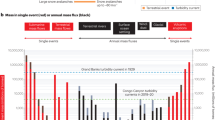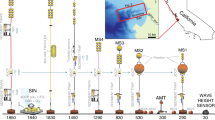Abstract
Off southwest Oahu, Hawaii, an array of current sensors recorded four successive episodes of downslope displacement associated with high-speed near-bottom currents of up to 200 cm/s and elevated water temperatures. These episodes coincided with the maximum storm effects of hurricane Iwa. Sensors from four moorings recorded increases in depth of as much as 220 m, implying downslope movement of as much as 2.4 km at speeds up to 300 cm/s. A succession of slope failures at or above the 110-m shelf break, each resulting in a turbidity current event, is the favored explanation.
Similar content being viewed by others
References
Shepard, F. P., 1963. Submarine Geology (2nd ed.). Harper & Row, New York, 577 pp.
Shepard, F. P., McLoughlin, P. A., Marshall, N. F., and Sullivan, G. G., 1977. Current-meter recordings of low speed turbidity currents. Geology, v. 5, pp. 297–301.
Shepard, F. P., and Marshall, N. F., 1978. Currents in submarine canyons and other sea valleys. In: D. J. Stanley and G. Kelling (eds.), Sedimentation and Submarine Canyons, Fans and Trenches. Dowden, Hutchinson & Ross, Stroudsburg, Pa., pp. 1–14.
Inman, D. L., Nordstrom, C. E., and Flick, R. E., 1976. Currents in submarine canyons: an air-sea-land interaction. Annual Reviews of Fluid Mechanics, v. 8, pp. 275–310.
Keller, G. H., and Shepard, F. P., 1978. Currents and sedimentary processes in submarine canyons off the northeast United States. In: D. J. Stanley and G. Kelling (eds.), Sedimentation and Submarine Canyons, Fans and Trenches. Dowden, Hutchinson & Ross, Stroudsburg, Pa., pp. 15–32.
Middleton, G. V., and Hampton, M. A., 1976. Subaqueous sediment transport and deposition by sediment gravity flows. In: D. J. Stanley and D. J. P. Smith (eds.) Marine Sediment Transport and Environmental Management. Wiley-Interscience Publications, New York, pp. 197–218.
Miller, M. C., McCave, I. N., and Komar, P. D., 1977. Threshold of sediment motion under unidirectional currents. Sedimentology, v. 24, pp. 507–527.
Shepard, F. P., Marshall, N. F., and McLoughlin, P. A., 1975. Pulsating turbidity currents with relationship to high swell and high tides. Nature, v. 258, pp. 704–706.
Lambert, A. M., Kelts, D. R., and Marshall, N. F., 1976. Measurements of density underflows from Walensee, Switzerland. Sedimentology, v. 23, pp. 87–105.
Reimnitz, E., 1971. Surf-beat origin for pulsating bottom currents in the Rio Balsas Submarine Canyon, Mexico. Geological Society of America Bulletin, v. 83, pp. 81–90.
Shepard, F. P., and Marshall, N. F., 1973. Storm-generated current in La Jolla Submarine Canyon, California. Marine Geology, v. 15, pp. M19-M24.
Gennesseaux, M., Guibout, P., and Lacombe, H., 1971. Enregistrement de courants de turbidite dans la Vallee Sous-Marine due Var (Alpes-Maritimes). Comptes Rendus Academie Sciences, Paris, t. 273, series D, pp. 2456–2459.
Normark, W. R., Chase, T. E., Wilde, P., Hampton, M. A., Gutmacher, C. E., Seekins, B. A., and Johnson, K. H., 1982. Geologic report for the O'OTEC site off Kahe Point, Oahu, Hawaii. U.S. Geological Survey Open File Report 82-468A, 32 pp.
Normark, W. R., Lipman, P. W., Lockwood, J. P., and Moore, J. G., 1978. Bathymetric and geologic maps of Kealakekua Bay, Hawaii. U.S. Geological Survey Map MF-986.
Winters, W. J., and Lee, H. J., 1982. Evaluation of geotechnical properties and slope stability of a calcareous ooze on the south-west slope off Oahu, Hawaii. U.S. Geological Survey Open-File Report 82-468B, 274 pp.
Coles, S. L., 1982. A visual reconnaissance of the bottom between 20 and 365 m depth offshore of Kahe Point, Oahu for the purpose of OTEC pipeline/cable routing. Hawaiian Electric Company, Inc., Honolulu, (in press).
Fornari, D. J., 1982. DSVTurtle dives off Kahe Point, Oahu, Hawaii, geological investigations of submarine slope microtopography: baseline studies to assist in future OTEC cold-water pipe designs and deployments. Offshore Investigations Limited, Chatham, N. Y., (in press).
Noda, E. K., 1982. Current measurements off Kahe Point, Oahu in support of the OTEC Program. Edward K. Noda and Associates, Honolulu, (in press).
Noda, E. K., 1983. Current and wave measurement off Kahe Point, Oahu, September 1982 to April 1983. Edward K. Noda and Associates, Honolulu, (in press).
Myers, J. J., Holm, L. H., and McAllister, R. F., 1969. Handbook of Ocean and Underwater Engineering. McGraw-Hill, New York, 1065 pp.
Noda, E. K., 1983. Special report. Affects of hurricane Iwa, November 23, 1982, offshore of Kahe Point, Oahu. Edward K. Noda and Associates, Honolulu, (in press).
Ocean Data Systems Inc., 1977. OTEC thermal resource report for Hawaii. Ocean Data Systems, Inc., Monterey, Calif., (in press).
Fornari, D. J., 1983. DSV Turtle dives off Kahe Point, Oahu, Hawaii. Offshore Investigations Limited, Chatham, N. Y., (in press).
Author information
Authors and Affiliations
Additional information
We dedicate this work to Gil Van Dyke, who lost his life in an accident during deployment of the current meter moorings.
Rights and permissions
About this article
Cite this article
Dengler, A.T., Wilde, P., Noda, E.K. et al. Turbidity currents generated by Hurricane Iwa. Geo-Marine Letters 4, 5–11 (1984). https://doi.org/10.1007/BF02237967
Received:
Accepted:
Issue Date:
DOI: https://doi.org/10.1007/BF02237967




